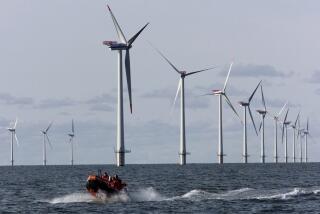Editorial: The beginning of the end of big, climate-changing power plants in California
- Share via
Plans to build a new natural-gas-fueled power plant on the Ventura County coast had been in the works for years, and the project seemed like an all-but-done deal just a few short weeks ago. The Puente Energy Project, to be built and operated by NRG Energy, had obtained most of the necessary approvals and was preparing for the final go-ahead from the California Energy Commission. It was a project similar to other recently approved plants in Huntington Beach and Carlsbad.
Then, suddenly, the deal started to come apart — much to the happy surprise of environmentalists who opposed it on the grounds that it was unnecessary and conflicted with the state’s clean energy goals, and to Oxnard officials and activists who were tired of industrial projects being sited time and again on their border. In just this small stretch of the California coastline, there are three power plants, two military installations, a number of oil fields and one slag heap so toxic that the Environmental Protection Agency declared it a Superfund site 10 years ago.
Now it seems likely that the Puente plant will never get built and, in fact, may herald a shift in how the state measures and addresses its need for electricity. Changes in technology and tough new energy policy goals have brought the end of the fossil-fueled-power era in California within sight, and hallelujah to that. The state’s power plants already generate more electricity than its residents can use, as a Los Angeles Times investigation found earlier this year, costing California’s ratepayers billions of dollars. There’s no sense in paying for another one if there are cleaner options.
California power plants already generate more electricity than its residents can use. There’s no sense in paying for another one if there are cleaner options.
This story starts in 2012, when the California Public Utilities Commission instructed Southern California Edison to make sure it would have at least 215 megawatts of backup power available when NRG retires two plants at its Mandalay Generating Station in 2020. Those plants use ocean water for cooling, a method that is so destructive to marine life that it is being phased out. Edison asked for proposals, then decided that the most reasonable and affordable of them was a more efficient natural-gas “peaker” plant on the same site on Mandalay Beach. Peakers are plants that run only when there is an unusually high demand on the power grid, such as during a summer heat wave or a natural disaster that knocks out other power sources.
The beginning of the end came when the Energy Commission asked the California Independent System Operator, the agency responsible for keeping the state’s electric grid running smoothly, to explore whether the backup power could be obtained through “preferred” resources. (Preferred power sources, like solar and wind, are those that don’t produce greenhouse gasses.) This was no idle question. The state has a strict mandate that half of the state’s power must come from clean energy sources by 2030. A legislative proposal to extend that mandate to 100% by 2045 died earlier this year, but may well return next year.
Cal-ISO determined that, actually, there are viable clean-energy alternatives to a gas-powered plant, thanks in large part to advances in battery technology that make it more cost-effective to store solar power for nighttime use or wind power for when the skies are calm. Battery storage costs have come down considerably since the Puente contract was awarded in 2014, making it increasingly affordable. Just in the last year, three battery facilities have started operating in Southern California, one of them in direct response to the shutdown of the Aliso Canyon natural gas storage facility near Porter Ranch after the largest methane leak in U.S. history. Increasing the state’s capacity to store power would also help California make more efficient use of its growing supply of renewable energy, rather than being forced to dump surplus electricity onto other states’ grids.
Following the pronouncement by Cal-ISO in August, the two energy commissioners assigned to review the Puente project declared earlier this month that they would recommend that the full commission deny the project when it voted later this year. Of course, this doesn’t mean the commission would have to do so. But the prospect is likely enough that NRG immediately asked that the commission put the project on hold, thus delaying any final decision. This way, the Puente project will still be an option if the green replacement power sources don’t materialize.
Let’s hope it doesn’t come to that. Southern California Edison has already gone back to the drawing board; it should move expeditiously to identify green options that are both available and reasonable. Only then will it be clear that California has reached an important milestone in its effort to stop investing in fossil-fueled power.
Follow the Opinion section on Twitter @latimesopinion and Facebook.
More to Read
A cure for the common opinion
Get thought-provoking perspectives with our weekly newsletter.
You may occasionally receive promotional content from the Los Angeles Times.









